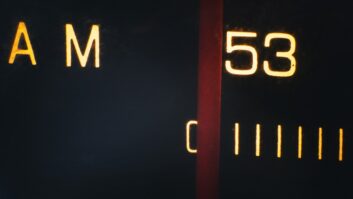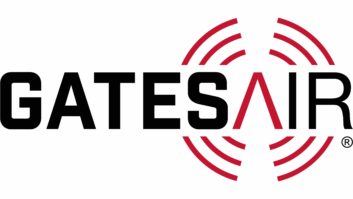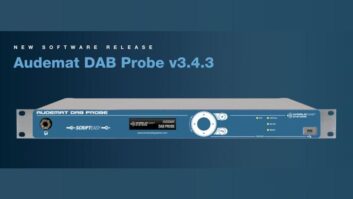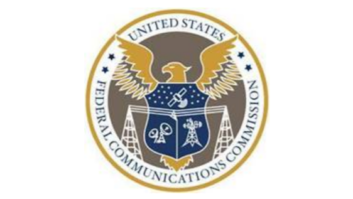The National Radio Systems Committee’s AM Improvement Working Group has published a study examining the effects of RF noise on AM radio reception in cars.
Radio World readers will find the study’s scientific detail of interest. Noteworthy was how RF noise on the road often did not vary amongst the diverse environments sampled. Overcoming downtown building signal degradation was more of a concern, according to the study’s authors. Additionally, the study found field strength projections of AM signals to often not be reflective of contour predictions.
The group’s study intended to provide a better understanding of how AM radio reception is affected by RF signal strength and noise in a range of roadway environments. The authors also provided some suggestions to overcome signal loss.
Measurements were collected with a computer-based software-defined radio (SDR) to record three 50 kW AM signals in Maryland as well as three quiet channels while driving a route from rural areas to downtown Baltimore.
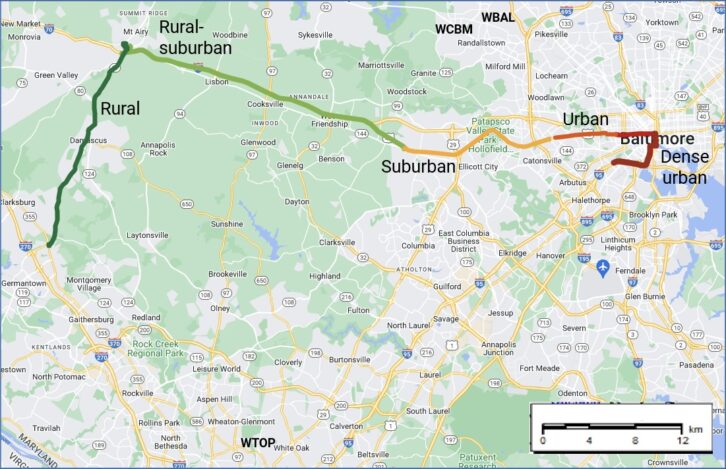
John Kean, senior engineer at Cavell Mertz, a division of Capitol Airspace Group and the report’s author, was assisted by Tom King of Kintronic Labs. David Hershberger, a retired senior scientist formerly with Continental Electronics, performed SDR data processing and contributed to the test’s design.
The AIWG supported the study to understand the current quality of AM signals on the roadway. Brian Henry, owner of Henry Communications and the group’s chair, said the measurements are believed to form the largest study of its type since a review of AM audio quality was conducted by NPR Labs and released in 2006.
Test particulars
The study focused on reception quality in five environment types: rural, rural-suburban, suburban, urban and dense urban. Kean told Radio World the study aimed to show how RF noise from power lines, traffic signals and nearby buildings are affecting AM signal reception in a moving vehicle. Kean and King traveled a route from Germantown to downtown Baltimore and collected the results in March 2023.

A vertical monopole antenna, mounted on the roof of King’s SUV, was used for calibrated and omnidirectional signal reception. The SDRplay RSPdx SDR recorded the entire AM band in IQ WAV files.
Equipment calibration was performed at the Columbia Gardens Cemetery in Arlington, Va., which provided a low-noise environment. Three frequencies (555 kHz, 1075 kHz, and 1625 kHz) were chosen to provide open channels for measurement of background RF noise in low, medium and high frequencies in the AM band, shown in the table below.
| Call Sign | City | Frequency (kHz) | Class | Power (kW day) | Antenna Mode |
|---|---|---|---|---|---|
| WCBM | Baltimore, MD | 680 | B | 50 | DA |
| WBAL | Baltimore, MD | 1090 | A | 50 | DA-N |
| WFED | Washington, DC | 1500 | A | 50 | DA |
Hershberger processed the SDR data file to extract noise levels on the three monitor channels as well as field strengths of the three measured stations. For readers interested in comparing the audible conditions to the objective data in the report, audio from all six frequencies was extracted and the NRSC plans to post it online soon.
The study’s findings
Kean emphasized that, contrary to expectations, AM noise levels, even in the city of Baltimore, were moderately low on the roadways. The audible noise observed on the radio channels was affected primarily by signal attenuation in the built-up areas, which makes the environmental RF noise seem worse.
(Read the NRSC’s Measurement of AM Band RF Noise Levels and Station Signal Attenuation.)
As a result, the most significant impact on AM signal quality was attenuation caused by buildings and other urban structures. Even the powerful signals of WBAL and WCBM were impacted severely in downtown Baltimore. Kean said that the measurements show the two signals falling from as high as 100 mV/m to less than 1 mV/m in less than a mile.

It’s something, he said, that’s not considered in a station’s groundwave contour maps, which can overestimate real-world field strengths. He added that in rural areas, the study found discrepancies between predicted and actual signal strengths, possibly due to inaccurate ground conductivity data and terrain effects.
Specific noise sources, like the overhead electric line for Baltimore’s Light RailLink, were also shown to have a direct effect on an AM signal. Other overhead power lines and some traffic signals caused RF noise, although these occurrences were of short duration. The study also observed that noise levels tend to decrease at higher frequencies in the AM band.
Recommendations
The NRSC made clear that its role is to disseminate the facts from this study and let the broadcast community make its own conclusions. But an overview of the report leads to some takeaways radio operators should consider.
The author recommends that station owners and engineers should encourage vehicle manufacturers to add what Kean considered simple features to handle noise impulses on the AM band.
“A noise blanker would handle many of the impulses we observed,” he said.
Kean observed that radio manufacturers focus much of their efforts on implementing DSP technology to improve FM performance in vehicles, noting that some car radio chip sets already have AM noise mitigation, but are disabled. If that same effort was applied to AM, he suggested this could improve sound fidelity.
He also said that closer transmitter placement would help overcome urban clutter loss, with real estate and operating costs understandably forcing some higher-profile AM transmitters to more remote sites.
Finally, the author also raised the possibility of single-frequency networks, which would involve an AM booster transmitter in the high-loss signal areas. Kean said this practice was developed and implemented by AM radio nearly a century ago. However, only recently has technology overcome the technical challenges, according to Kean, within the last decade.
The FCC opened a comment period on SFNs in 2016.
[Related: “Synchronous AM’s Long and Tortuous History”]
Kean and Henry suggested designing a successful booster requires research to ensure that the synchronization would minimize “multipath” between the coverage area of the primary and booster transmitters.
Kean plans to conduct laboratory measurements soon, to define the multipath parameters. In the next step, he envisions setting up a small test transmitter in an urban area and conducting signal measurements to verify the coverage and multipath parameters.
If a test in a major city is successful, it might make SFNs a good business case for AM operators, Kean said.
